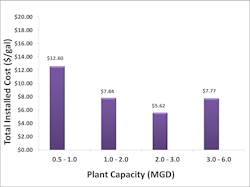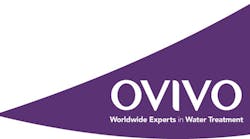Membrane Bioreactors (MBR) may have a reputation for being costly, but they do not have to be.
A survey of 137 MBRs in the U.S. showed that an Enviroquip MBR using flat plate technology is typically half to three-quarters the CAPEX cost of other MBR suppliers. CAPEX is certainly important, but what about OPEX?
While there is a tremendous amount of data publicly available on energy and chemical consumption of MBR systems, there is little to no data published on labor requirements of these systems.
Labor can account for more than half of a plant’s operating budget, so why is it being ignored?
The survey of 137 MBR plants conducted by a third party analyst shows that an Ovivo (formerly Enviroquip) MBR requires 50% less labor to run than other MBR suppliers.
A Closer Look
While the idea of installed cost comparisons is nothing new, the execution of those comparisons can be challenging as no two wastewater plants are exactly alike. This is especially true for newer technology like MBR where the number of installations is somewhat limited compared to conventional systems.
Another challenge specific to the comparison of different MBR technologies is that the technology has several different drivers, including tighter effluent limits, space limitations, costs, etc.
It is also used in a myriad of applications, including municipal, industrial, tribal, resort, LEED, greenfield, retrofit, package plant—all with different cost impacts. Procurement methods and MBR system supplier scope of supply has a large impact on the final project costs.
To combat these challenges, focus was placed on MBR installations treating municipal-type (non-industrial) wastewater with flows less than 10 million gal per day (mgd).
Beginning in 2008, MBR installed cost data was gathered from multiple documented sources, including city documents, press releases, news articles, contractors and operators/owners. Data collection has been ongoing, and the CAPEX data presented here is current as of October 2011.
Upon initial review of the data, two things became clear: Installation costs show wild variations below 0.1 mgd and the amount of data above 5 to 6 mgd is extremely limited due to the lower installed base in the US.
A majority of the municipal wastewater plants in the U.S. are below 6 mgd. As such, the original dataset of less than 10 mgd was culled for MBR plants with 0.5 to 6 mgd, and what remained were 84 data points of two types: 43 Ovivo MBR facilities and 41 other MBR facilities.
The data presented shows significant cost differences between the flat plate system and other suppliers. Each case is different, but here are the top 10 reasons why the flat plate system is believed to cost less:
1. Reduced equalization
2. Less screening
3. Process intensification
4. Reduced electrical
5. Simplified controls
6. Fewer recycle streams
7. Optimized clean-in-place
8. No chemical storage tanks
9. No tank liners
10. Smaller buildings
The data showed that an Ovivo MBR averages about half of the manpower of other MBR systems.
To normalize the data, it is reported in terms of the number of full-time employees (FTE) versus plant capacity (mgd). The graph shows that the minimum number of operators is approximately one employee per mgd for all types of MBR systems.
The numbers are based on 40-hour work weeks. Some of the plants are contract-operated where an operator is only onsite a few hours a day or week, and therefore less than one.
While there is no significant difference on the low end, there is a big difference on the average and maximum number of FTEs per mgd. An average Ovivo MBR has 1.8 operators per million gal of treated wastewater per day. This difference can equate to hundreds of thousands of dollars saved per year in operations and maintenance costs.
On average, an Ovivo MBR is half the CAPEX and half the labor OPEX of other MBR systems.
Kimberly Mathis is business development manager of MBR systems at Ovivo USA LLC. Mathis can be reached at [email protected] or 512.834.6035.



